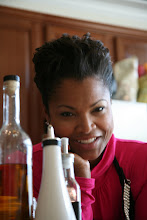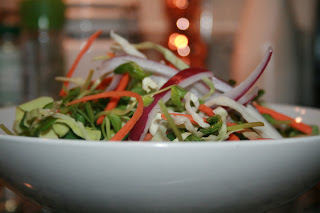




 Cucumbers might just be God’s gift to women (no offense men). A natural diuretic, cucumbers contain over 95% water which is naturally distilled meaning that a little cucumber goes a long way when it comes to the prevention of water retention--which can be akin to the “devil” when it comes to a woman’s body.
Cucumbers might just be God’s gift to women (no offense men). A natural diuretic, cucumbers contain over 95% water which is naturally distilled meaning that a little cucumber goes a long way when it comes to the prevention of water retention--which can be akin to the “devil” when it comes to a woman’s body. 
….the first step to transitioning to a healthy lifestyle is learning to prepare more foods at home and limit eating out. Preparing your own food is the best way to be sure of what’s on your plate. Controlling the contents of your food helps you to better manage sodium, cholesterol, and calories as well as the quality of ingredients. But, before embarking on your new life as a home cook, you must first get your kitchen in shape. Here are just a few ideas to get you started:
Assess Your Pantry. Whether it is empty or full, taking stock of what you keep in stock is important. When it comes to spices, if all you have is salt, and salt based products, throw them out. Limit yourself to a basic sea salt and one other spice--such as seasoning salt or garlic salt--that has salt in it. Add a few new staples such herb seasoning blends, pepper blends, citrus peels, and the like which add tons of flavor, but reduce the amount of salt used.
Next, limit the number of prepared sauces, including salad dressing, in your pantry. Prepared sauces tend to be high in sodium and calories. The best option is to make your own. The best way to do so is to keep on hand ketchup, apricot preserves, pure honey, Dijon mustard, various vinegars, and extra virgin olive oil. These are the bases of many homemade sauces and individually pack a lot of flavor.
Spices and sauces tend to be the biggies of those pantry items that silently add tons of calories, salt, and fat to your food and even a little bit is sometimes too much. But, in addition to spices and sauces, packaged and canned foods also need to be carefully considered when stocking the pantry. In this area, good pantry staples are basmati rice, barley and similar grains, whole-grain and veggie pastas, no sodium stocks (homemade is the best), no sodium canned tomatoes (diced, whole, or sauced), and canned fruit with no sugar added.
The Deep Freeze. The more you have available at your beck and call, the more likely you will be to prepare foods yourself. Stock your freezer with fresh meat and flash frozen veggies. Like the meat you freeze just after purchase, flash frozen veggies are frozen at their peak of ripeness. So, any fruits and veggies you purchase from your frozen foods area are almost as good as buying fresh.
Pre-portion meats in the quantities commensurate with the types of meals you plan to prepare. For example, freeze one boneless skinless chicken breast for chicken salad. Freeze four bone-in chicken breasts in case you plan to have company. Do the same with beef, pork, and turkey. You can even pre-portion ground meats in preparation for meat loaves or ragu sauce.
Avoid stocking up on prepared frozen foods such as pre-packaged dinners and entrees. Items slated to be fast and easy might be just that, but they are likely to have many preservatives and lots of sodium to make them that way.
Pots, Pans, and other random supplies. Make sure you have the right stuff for the job. Stock your kitchen with the following items for the best results in the kitchen:
One 12 qt Stock Pot with lid
One 4 to 5 qt dutch oven with lid
One oven safe Grill Pan
One stainless steel or other non-reactive 12 inch fryer
One non-stick 12 inch fryer
One non-stick 8 inch omelet pan
One or more 2-3 qt sauce pans with lids
One or more small sauce pans with lids
Two or more large colanders
One large wooden cutting board for all things not meat and One non-porous cutting board for meat prep
Two or more mixing bowls of various sizes
One large and one small whisk
One all purpose serrated knife
One 8 inch chef’s knife (one that you love and can last forever)
Several heat resistant spoons, “spoonulas”, and spatulas
Baggies and storage bowls
Serving ware, flatware, napkins and other essentials that make you want to sit down and eat at home
These suggestions are not the end all be all to the plethora of options for your kitchen. But, it serves as a guide for those who are unsure of where to start. It also serves as a baseline for your shopping list. Whatever you do, by all means avoid the snack aisle!